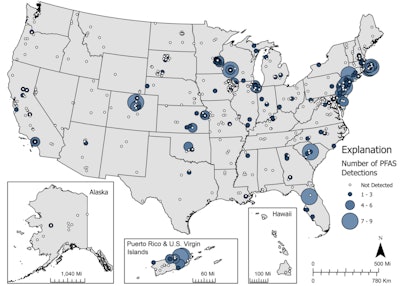
Quest Diagnostics announced the availability of a consumer-directed blood test for exposure to PFAS "Forever Chemicals," synthetic chemicals that are present in consumer and commercial products, and in the environment in some industrial areas.
Researchers often use people’s blood PFAS levels as a proxy for exposure to perfluoroalkyl and polyfluoroalkyl substances. Using serum or plasma blood specimens (blood taken from an arm) instead of capillary blood specimens (from a fingerstick), Quest's PFAS (Forever Chemicals) Test Panel:
- Quantifies levels of several specific PFAS chemicals identified for potential health risks.
- Reports the sum of those levels by three general risk categories.
This is important because PFAS chemicals are thought to accumulate and linger in the environment and in the human body. People at high risk of elevated exposure may benefit from greater access to the insights provided by the new blood test, Quest Diagnostics said in its announcement. The test offering coincides with recent guidance from the Centers for Disease Control and Prevention (CDC) and recommendations from the National Academies of Sciences, Engineering, and Medicine (NASEM).
"According to NASEM, individuals whose results are in the third, or highest, category (levels of 20 ng/mL or above) may benefit from additional medical care," Quest said. "While most individuals have some level of PFAS exposure, an estimated 9% of Americans have PFAS levels of 20 ng/mL or higher, typically due to environmental or occupational exposure."
PFAS chemicals are present in many consumer, commercial, and industrial products, and in the water, air, fish, and soil at locations across the nation and the globe, according to the U.S. Environmental Protection Agency (EPA). Certain people are more exposed to PFAS than others, such as those living near a facility that manufactures fluorochemicals or areas of documented PFAS environmental contamination.
For years, PFAS contaminants have been found in drinking water originating from the Cape Fear River in North Carolina, for example. The forever chemicals found in the Cape Fear River were detected through a nontargeted testing method developed at University of North Carolina–Chapel Hill that broadens researchers’ abilities to identify the hazardous compounds.
“Current testing methods used by the EPA can only find the PFAS that we already know exist,” said Dr. Erin Baker, who runs the Baker Lab at UNC–Chapel Hill. “That means we have to rely on chemical companies to provide a list of what they manufacture and hope those samples are comprehensive.”
According to Baker, while genomic, transcriptomic, and proteomic analyses have rapidly progressed over the last two decades, certain small molecule measurements have not advanced to as great a degree, even though they are essential for the direct analysis of chemical exposure. The Baker Group is working to develop and optimize new analytical and computational approaches for these measurements. Specifically, the researchers are using various combinations of separation methods including automated solid phase extractions, liquid chromatography, supercritical fluid chromatography, ion mobility spectrometry, and mass spectrometry to enable the analysis of thousands of longitudinal samples over the lifetime of exposure. Ultimately, the UNC–Chapel Hill researchers are trying to connect multiomic data with available phenotypic data.
"Researchers are developing and testing methods to determine where PFAS come from, how they move through the environment, and how people are exposed," the EPA has explained. "This information is crucial to knowing how to ‘break’ the exposure pathway and thereby prevent people from being exposed to PFAS."
A variety of federal agencies in the U.S. are involved in PFAS research and testing, according to the EPA. For example, the U.S. Food and Drug Administration (FDA) assesses PFAS issues related to the general food supply, food packaging, and cosmetics. In addition, the EPA published a national PFAS testing strategy and has initiated nationwide monitoring at more than 10,000 public water systems. Private drinking water wells may harbor PFAS chemicals as well. In 2021, the EPA released a strategic roadmap for U.S. states and territories to focus on safe PFAS levels.
According to Quest, the PFAS Forever Chemicals test can be ordered by consumers. Unlike some direct-to-consumer tests, this one involves physician oversight and consultation on request with a licensed physician, the company said. In addition, for quality assurance, Quest Diagnostics is a Clinical Laboratory Improvement Amendments (CLIA)-certified lab.
When testing is completed, results are provided on a patient portal. Moreover, a PWNHealth (now an Everlywell company) care coordinator will contact any individual whose test results suggest elevated PFAS exposure (20ng/mL or higher) to recommend a physician consultation.
Specifically, when an individual purchases a PFAS test online, a physician from the PWNHealth independent, third-party physician network will review the request and place an order. Once the order is submitted, an individual can schedule an appointment for a blood draw at a Quest Diagnostics patient service center, Quest said in its announcement, adding that it was also aiming for employer and research-based testing for at-risk populations.
While communities in the U.S. have been concerned about possible health effects from PFAS exposure, testing for PFAS does not provide information for treatment or predict future health problems, stated the CDC's Agency for Toxic Substances and Disease Registry.

















